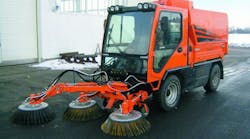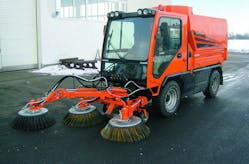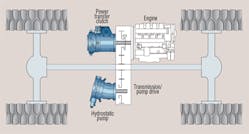Vehicle drive systems use a drive technology that best serves the application. On-highway vehicles typically use mechanical, geared transmissions or hydrodynamic automatic transmissions in combination with gears. Off-highway vehicles often use hydrostatic (hydraulic) transmissions because of their compact size, control and design flexibility, wide speed range, and low-speed, high-torque operation. Mechanical and electromechanical drives are also used on off-highway equipment, and a combination of technologies — or even hybrid drives — may be used to suit particular applications.
However, it’s rare to find a vehicle with two transmissions. But that’s the case with the vehicles containing an Eco-Drive, from Ladog GmbH, Zell am Harmersbach, Germany. The Eco-Drive is based on drive system technology developed by Bosch Rexroth, Lohr, Germany. It automatically switches between a hydrostatic drive and geared transmission.
A smooth transition
The geared transmission provides the best fuel economy for road speeds exceeding 28 km/hr. However, the hydraulic drive provides the high torque and controllability of a hydrostatic transmission at speeds less than 28 km/hr. Shifting between the two drives is accomplished with an electromechanical clutch. The transition is smooth because it occurs when the pump and gearing are rotating at the same speed and the engine is operating at 2000 rpm. This corresponds to about 28 km/hr. Once in the high-speed mode, the vehicle can attain a top speed of 40 km/hr with the engine running at 3000 rpm.
The vehicle’s electronic control monitors engine and wheel speeds to ensure smooth shifting. It also controls shifting of the clutch and displacement of the hydrostatic pump and wheel motors. When the electronic control signals the clutch to engage, it also signals the pump to shift to zero displacement. When in the high-speed mode, if the engine speed drops below 2000 rpm, the control will disengage the clutch and bring the hydraulic system back on line.
Initial test results reveal that the Eco-Drive can reduce fuel consumption by as much as 20%. It also runs quieter than its conventional counterparts and produces less emissions. Furthermore, life of hydraulic components is extended because they do not operate when the vehicle operates in its high-speed mode. In addition, the fully automatic operation reduces required operator training.
Versatile operation
The hydrostatic drive consists of a model A4VG56EP variable-displacement axial-piston pump supplied by Bosch Rexroth. The pump feeds a pair of Rexroth model A6VM107EP variable-displacement axial-piston motors. This setup provides a wide range of speed and torque because pump flow can be varied from minimum to maximum while motor displacement varies from maximum to minimum, respectively.
For example, with the machine idling, the pump and motors are at zero displacement. When the operator depresses the accelerator pedal, the motor displacement increases to maximum, and pump displacement remains at minimum. This produces low speed and high torque for accelerating the vehicle from rest. As the operator depresses the accelerator further, pump displacement increases and motor displacement decreases, causing vehicle speed to increase.
With the pump at maximum displacement and the motors near minimum, the vehicle can achieve 28 km/hr. To go faster, the control automatically shifts the vehicle into its mechanical drive mode. The control reduces engine speed to 2000 rpm, shifts the clutch to engage the geared transmission, and reduces pump and motor displacement to zero.
By monitoring speeds, the control synchronizes these events for quick and smooth shifting. Once the vehicle shifts to its high-speed mode, it can achieve 40 km/hr by increasing engine speed to 3000 rpm.
Of course, hydraulics also powers a variety of implements. For example, the sweeper attachment shown uses multiple hydraulic motors to spin brushes and cylinders to position them. Other optional implements include snow blowers, plows, mowers, etc. A second, open-loop pump is used for powering these implements.
Technical information for this article was provided by Heinz-Gerhard Essig, of Bosch Rexroth, Lohr, Germany. For more information, contact Terry Hershberger in the U. S. at [email protected].



